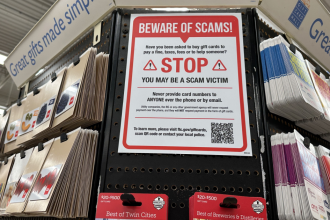If you’re thinking of stocking up on food and other items, you’re not alone. Between supply chain issues and rising food prices, no one wants to be caught off guard with nothing left in their pantry (remember the whole toilet paper situation of 2020?).
It’s always a good idea to have a little extra food on hand and know how to stock your cabinets just in case. But you also want to be smart about it and not break your budget.
Stock Up the Pantry, But Don’t Go Overboard
All right, let’s just say this right out of the gate—you don’t need to fill your entire cart with 15 bags of beans, 20 bottles of ketchup and enough toilet paper to TP your entire neighborhood. When you go that extreme with stocking up, shelves go bare and there’s nothing left for the rest of us. Oh, and that’s what creates a “run” on specific products too. Aka when everyone rushes to the store to buy up all the toilet paper. So be prepared, but keep your cool. Don’t fall into the extreme stocking up frenzy.
And grocery stores have learned a thing or two about how people go crazy with stocking up too. They’ve learned their lesson from the first wave of COVID-19 lockdowns and are starting to limit how many cleaning products, paper products, toiletries and meat you can buy at a time.2
Items to Stock in Your Pantry
- Beans and legumes
- Rice and grains
- Peanut butter
- Jelly and preserves
- Tuna
- Canned chicken
- Canned vegetables
- Canned fruit
- Nuts
- Cereal
- Powdered milk
- Nondairy milk (almond, oat, etc.)
- Sugar
- Yeast
- Crackers
- Canned soups
- Flour
- Popcorn
- Rolled oats
- Garlic
- Onions
- Potatoes
- Pasta
- Tomato paste
- Rice cakes
- Dried fruit
- Condiments
- Spices
- Coffee and tea
How to Stock a Pantry on a Budget
Set a budget.
Stocking up your pantry? Yep, you need to add it to your budget. If you know you want to stock up on dry goods the next time you hit the grocery store, then figure out how much you want to spend on that. Maybe that means you up your food budget by $50 for the month or maybe you’re adding a line item just for Costco—whatever you do, just make sure you budget first, not after.
Make a list.
All right, we gave you a list of things that are great pantry staples, but that definitely doesn’t mean you have to buy everything on that list. Don’t go overboard! Pick and choose food items that actually make sense for your family to buy. Then, make a list and stick to it—just like you would with your regular grocery shopping.
Pick staple items you can use for meal prep.
When you’re trying to figure out how to stock your pantry, remember to go in with a game plan. What kinds of meals could you make with these pantry items on your list? That will help keep your pantry packing focused and help keep the random stuff out. If things were really bad, could you just crack open a can of beans? Of course. Still, let’s assume that’s not the case and stock that pantry full of things you can actually use to make full-on easy pantry meals. Also, you can totally eat a can of beans on a regular night too—no judgment.
Buy food you normally eat.
Here’s the golden rule when it comes to stocking up your pantry on a budget. Are you ready? Don’t buy things you wouldn’t use. Pandemic, natural disaster, pigs falling from the sky, or whatever emergency you’re trying to get ahead of—just buy the stuff you know you’ll eat anyway. That way, when it’s all said and done, you won’t be stuck with 20 cans of tuna when you never touch the stuff. If you didn’t catch it the first time, we’ll say it again—only stock up on food that you actually eat. Your budget and stomach will thank you.
Steer clear of junk food.
Maybe you’re sure your kids (or you!) couldn’t make it two weeks without animal crackers. We get it. Just be sure you’re not stocking up your pantry with every cookie that Pepperidge Farm and the Keebler Elves ever made.
Look for sales and use coupons.
This is how to stock your pantry 101 right here. Deals are everywhere! Keep your eyes peeled for buy one, get one free and 50 cents off a can types of sales. They happen all the time, you just have to be on the lookout for them. When they do go on sale, that’s the time to stock up. And let’s not forget about a little thing called coupons—you got to love them. They come in handy for everything and can even help you save when you’re stocking up your pantry.
Buy in bulk.
You’ve got to be careful with buying in bulk because if you’re not, you’ll end up busting your budget pretty dang fast. So, do a little price comparison. If you know you’re going to stock your pantry with 12 cans of black beans, price out what each can would cost you at a grocery store versus a bulk store.
Try our free Meal Planner to save money on groceries!
Let’s say you do some price checks and find out you can pick up a 25-pound bag of long-grain rice for about nine bucks at Sam’s Club. Sounds like a good deal, right? But just to be sure, you check over at Kroger. Twenty-five pounds of rice there would set you back about $15. That’s almost double! Good thing you crunched the numbers before you spent any money. It pays to do your research and compare prices before you head out the door to shop—so follow through with it (you’ll be glad you did).
Buy generic.
Brand-name Bush’s black beans are about $1 at Kroger. But the generic Kroger brand costs a little less at 79 cents a can. Now, a 21-cent difference might not seem like a huge deal, but if you’re buying 12 cans of beans, that adds up—to $2.52 to be exact. Multiply that savings by all the different things you’re stocking your pantry with and buying generic can save you a ton of money.
Do a pantry audit.
A what? A pantry audit, folks. It’s not as weird as it sounds. Once or twice a year, dig through your pantry and read labels, check expiration dates, and see how long you’ve had the stuff. This is also a great way to know what you really have on hand and what you’ve run out of. Plus, it will save you from buying repeats of things you already have, which all adds up to more savings for you (score!).
How to Prepare Your Pantry and Your Budget Against Panic Buying
Here’s the deal. You might be feeling a lot of pressure to go out there and stock up your pantry, but really, you should always have some staples on hand. It’s never a great idea to have absolutely zilch in your cabinets, so keep some food on the shelves—no matter what’s happening with the world or the economy.
And making that little bit of effort doesn’t have to totally blow your budget either. Up the grocery line by a few bucks and just grab a couple extra canned goods each time you shop. That way, you don’t have to do a massive overhaul to keep your pantry stocked up on essentials. And the next time people start gearing up to raid the shelves, you won’t have to be one of them.
Ready to keep a closer eye on that grocery budget (and your pantry)? Budget for free with EveryDollar. It makes it super easy to stay on top of your budget anywhere, anytime!
Read the full article here
















